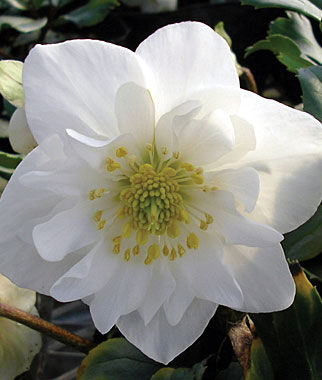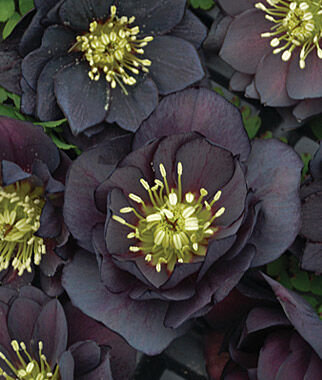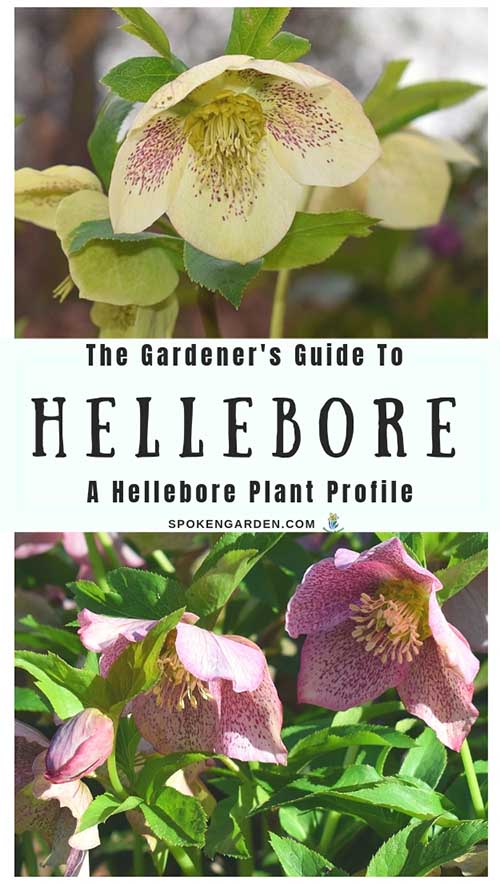Learn all about Hellebores in this gardener’s guide of these beautiful perennials, including plant care, companion plants, frost-hardiness, history, and more.

Learn about the sunlight needs and frost-hardiness of hellebores.
What do you visualize when you think of winter and your yard?
Do the terms “dark, dismal, or drab” come to mind? Well, Hello Hellebore!
In our Hellebore plant guide below, you’ll learn about the many benefits this beautiful winter bloomer has to offer.
When everything is dark, cold and leafless, this little pop of color can make a world of difference to an otherwise stark landscape.
So, what is a Hellebore? Where are they native?
This post will give you the confidence you need to grow and care for them on your own.
Quick Plant Care Facts
| Sun Exposure | Partial to Full Shade |
| Water Needs | Moderate watering needed |
| Soil Needs | Prefer well-draining, rich soil that can stay moist. |
| Cold-Hardiness Zones | USDA hardiness zones 6 to 9. |
| Bloom Time | Winter into Spring |
| Flower Colors | Soft green, white, pink, yellow, red, purple, or cream. |
| Mature Height/Width | 1ft to 3ft tall and wide |
| Plant Spacing | 1ft to 3ft apart, depending on specific plant |
Do you want to plant your bulbs right the first time? Read our book, How to Plant Your Garden Bulbs, eBook or Paperback.
Let’s get started on your journey to better hellebore plant care and understanding!
Read our Hellebore plant guide post below to learn:
- How to maintain and care for hellebores in your yard.
- The best growing conditions for your hellebores.
- Quick history of hellebores.
- Fun facts and so much more.
By the way, our Hellebore plant guide below is meant for anyone who wants to learn more about this plant. We hope you enjoy it!
Hellebores and Why You Should Love Them
First, hellebores add a pop of color to winter gardens which might otherwise look drab and dull. Due to their early bloom time between January and March, you can add winter interest year after year by planting hellebores around your yard.
Plus, with the abundance of color options available and their evergreen mounds after blooming, you can enhance your yard all year long!
In addition, hellebores are very low maintenance which makes them suitable for any level of gardener, especially beginning gardeners. As long as they have full to partial shade, they are tough, resilient plants that bloom with elegant, downward-facing flowers.
Finally, they are both deer and pest-resistant. These plants tend to be very poisonous to both animals and humans which means you need to maintain caution when planting them.
Hellebore: History and Uses
As you begin your journey to understand more about hellebore plant care, a good place to start is to first learn about their family group, their history, and their uses. Read on below for more!
Ranunculaceae Family
Hellebores are in the Ranunculaceae family group which consists of over 2000 species of herbaceous or evergreen perennial flowering plants.
Also known as the buttercup family, family members include a mix of annuals or perennials, climbers, and shrubs. The plant parts of most family members are toxic to humans and animals.
Ranunculaceae family members have been valued for a few uses over time, including:
- Poison (in Roman times)
- Herbal medicines
- Spices
- Treating epilepsy
- Treating high blood pressure
- Ornamental gardens
- Other medicinal uses
Other members of the Ranunculaceae family include Ranunculus, Clematis, Buttercups, and Delphinium, and many more.
History of Hellebores (in Brief)
Hellebores are native to Eurasia, specifically Mediterranean Europe. They made their presence known throughout history in Europe and eventually North America.
There is a long, interesting history of hellebores back to Ancient Greece.
Research indicates that Hellebores were used as a biological weapon by the Athenians due to their ability to cause diarrhea when ingested. Apparently, they poisoned the wells of their enemies with hellebores to make them sick. It makes sense why Hippocrates used these plants as ancient, medicinal laxatives.
By the Middle Ages, hellebores were used to drive away evil spirits and were said to cause madness. They were also used as an ingredient in witches’ ointments.
Eventually, hellebores made their way to Europe and North America. Today, they have continued to grow in popularity due to their winter-blooming flowers and variety of cultivars available.
Symbolically, different cultivars have different meanings and folklore depending on where they originated and their bloom time. For example, the famous Christmas Rose, or black hellebore, was said to bloom very early near Christmas time.
Today, hellebores continue to grace winter gardens in North America, Europe, and elsewhere with their early blooming beauty. They are especially favored in woodland or cottage gardens.
Hellebore Care
Coming soon!
Are Hellebores Frost Hardy?
This is a great question and it gets asked a lot. In general, YES, Hellebores are frost friendly and hardy.
Some species might be more averse to frost than others, so make sure to check with your local nursery to be sure they carry frost hardy species before purchasing. If you have unseasonably cold weather where the temperature drops way below the hardiness of most hellebores, which is around zone 4 or 5-degrees F° or 15-degrees C°, the blooming flower should be fine under frost or cold temperatures.
However, there could be cold damage to flowers if other environmental factors are right for that damage, like moisture levels, microclimates, extreme weather, and others.
If you’re looking to grow hellebores in your garden, check out the North American Rock Garden Society and the different Hellebores they feature.
Do Hellebores Need Sun or Shade?
As our table states above, hellebores are shade-loving plants.
However, hellebores can tolerate a wide range of sunlight conditions from shade to partial sun. They could continue blooming in the spring season and can handle the spring sun, but most prefer shadier locations.
Try planting hellebores beneath trees or large shrubs for shadier conditions.
Hellebore Care (in Brief)
- Use a hand trowel or small shovel for planting.
- Use pruning shears to remove excess roots or any damaged tissue before planting.
- Compost and natural fertilizers can be added for better plant health.
- Long-handled watering wand with nozzle can be used for watering your hellebores.
- Ladybug eggs and lacewing eggs are natural predators to aphids.
Hellebore Companion Plants
Hellebores are one of the best plants to plant in your garden for continuous winter flowering. Plus, their flowers change colors progressively from winter to spring causing interest in the garden for multiple months in a row.
In the winter season, you will be a bit more limited to foliage or other winter bloomers that grow in similar conditions, but you still have options.
Companion plants to consider:
- Hosta
- Foxglove
- Bleeding Heart
- Cyclamen
- Wood Sorrel
- Ferns
Winter Flower Care Reading Material
If you’re looking for further educational resources about all types of winter-blooming plants, these books below are great educational references!
American Horticultural Society Encyclopedia of Plants and Flowers
This is a great reference guide for tons of different perennial and annual plants from the American Horticultural Society.

Hellebores for Sale
If you don’t already have hellebores in your garden, you may be ready to purchase your own plants. Click on either of the pictures below for a current price.
Or, do you need to stock up on other types of plants? Here’s a great winter deal that will help you fill up your garden with next season’s plants. We have two hellebores in our front garden and here are two showcased varieties below from Burpee, with many more to choose from.
Conclusion for Hellebores
Today, hellebores remain a popular choice for winter gardens. Whether you want to add a pop to your garden or add winter interest, pick your favorite color and plant some hellebores!
Just be careful to use gloves whenever handling the flowers and stems due to their potentially poisonous parts.
Ideal for woodland or cottage gardens, these tough, resilient plants will liven up gardens year-round. With very little maintenance necessary and their beautiful colors, hellebores are the perfect plant to add to your winter garden.
Now we want to hear from you!
What other questions do you have about hellebores that we didn’t answer above? Let us know by leaving a quick comment below. Thanks!
You can find more of hellebore care needs, when it flowers, its uses, and more by becoming a Plant Profile Club member.
Want to learn about other plants in your garden? Check out some of our previous plant profiles:
- Daffodils: A Gardener’s Guide
- Crocosmia: A Gardener’s Guide
- Primroses: A Gardener’s Guide
- Tulips: A Gardener’s Guide
- Grape Hyacinth: A Gardener’s Guide
- Sunflowers: A Gardener’s Guide
See you in the garden!
~ Sean and Allison
P.S. Find us on Pinterest, Twitter, Facebook, and Instagram so you don’t miss a thing!
References Used:
- References: Sunset Western Garden Book (2007)
- USDA
Spokengarden.com is a participant in the Amazon Services LLC Associates Program, an affiliate advertising program designed to provide a means for sites to earn advertising fees by advertising and linking to Amazon.com





